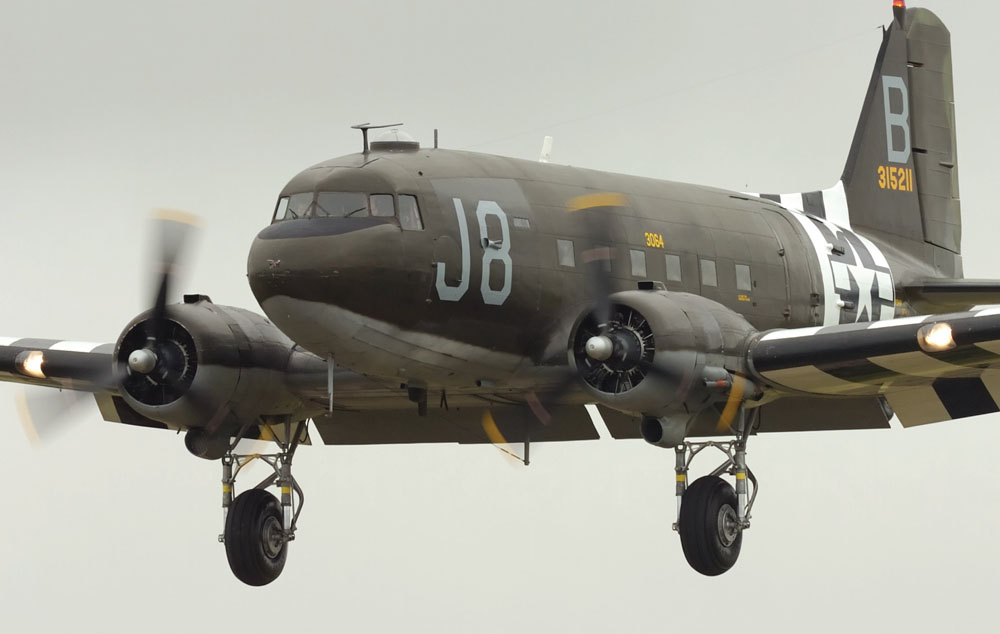
Like the Spitfire, and a relatively small number of other classic aircraft, the DC-3 / C-47 / Dakota is a breed apart, distinguished not only by her exceptional design, engineering, durability, performance, and her many other fine characteristics, but by her enormous base of admirers. To the millions of people who have been her passengers and the enthusiastic captains and crews who have operated her for more than seventy years, to her countless fans in the aviation world and those whose lives have been affected by her in the most dramatic ways, she is unforgettable.
Without question, this Douglas plane changed history, opening the era of modern air travel in the 1930s and as the backbone of Allied air transport in the war. In its Santa Monica, Long Beach, and Oklahoma City plants, Douglas Aircraft produced 10,349 of the planes. More than 2,400 additional examples were built by Japan and Russia both under license and without such permission.
Her lineage began with the DC-1, a low-wing all-metal (except for the fabric-covered control surfaces) monoplane that first flew in July 1933. The DC-1 offered enclosed passenger accommodation, trailing-edge flaps and retractable landing gear. She was the prototype for the DC-2 production model that led to the Douglas Sleeper Transport, whose first flight came in December 1935. The DST had sleeping berths for sixteen passengers and, though only built in a small run, made a great impression on transcontinental night flights. It evolved into the DC-3, whose maiden flight from Clover Field, Santa Monica, California, on December 17, 1935, marked the beginning of a major revolution in air travel. This came on the 32nd anniversary of the Wright Brothers’ pioneering flight at Kittyhawk, North Carolina.
With the entry of the United States into the Second World War, the U.S. military realized that, in the DC-3, it had a truly important multipurpose transport aircraft that would be crucial to the Allied war effort. Oddly, it would also become the only plane to be operated by every major combatant on both sides in that war. Built and flown by both the Soviets and the Japanese, the American DC-3—now designated C-47—was flown by the Germans as well. They formed a fleet of such aircraft captured from various air lines during the Nazi blitzkrieg campaign.
A significant surviving veteran of the war, the C-47A N1944A, is an impressive example of the type. Her wartime squadron code was J8-B and this historic plane was completed at the Douglas Aircraft Company, Long Beach, California plant on February 14, 1944. With only two hours and fifty-five minutes flying time on her airframe, she was accepted by the U.S. Army Air Force on March 1st. By late May she was based in England at AAF Station Upottery in Devon, one of the key D-Day launch bases of the 101st Airborne Division “Screaming Eagles.” Upottery was the base of Lieutenant Richard Winters and the men of Easy Company, 506th Parachute Infantry Regiment, the subjects of the book and television series Band of Brothers. From Upottery, J8-B was among eighty-one C-47s to participate in the airborne assault on Normandy of June 6th, bringing their paratroopers to the landing zones of northern France behind Utah Beach.
In 2008 the European Union ended the passenger-carrying career of the greatest, most significant Allied workhorse of the Second World War, the marvellous, ubiquitous Douglas DC-3 (the Dakota to most Britons.) This magnificent twin-engine airliner went to war all over the world in the 1940s as the C-47, playing a vital role in that conflict, helping to win it and to liberate millions of Europeans in the spring of 1945. General Dwight Eisenhower, in his book Crusade in Europe, wrote: “Most senior officers regard as the most vital to our success in Africa and Europe the bulldozer, the jeep, the two-and-a-half-ton truck, and the C-47.” None of them had been designed for their combat role.
In its 175-page EC Regulation 1899 / 2006, the European Union declared a new set of requirements for all passenger-carrying aircraft that operate in EU countries. The directive fails to distinguish between modern airliners and the rather small, vintage aircraft like the DC-3, which are seen mainly at airshows and similar events. It demands that all passenger-carrying airliners must now be fitted with escape chutes (to deliver DC-3 passengers to the ground four feet below the exit door), passenger oxygen masks (for aircraft that never fly at altitudes where supplemental oxygen is needed), and other equipment normally found in a jumbo jet. Such additions are both prohibitively expensive and fundamentally impractical for the old, reliable DC-3, several hundred of which are fully airworthy around the world, many of them still earning their keep on a daily basis. Does this legislation really mark the end of passenger flying in this fine old machine? Is it really the death knell for her in the job she was created to do seven decades ago? Rules can be changed, if and when sufficient and appropriate reason is applied.
In Skytrain, the fascinating wartime and post-war history of the C-47 is traced, along with the pre-war, wartime, and post-war story of the DC-3 / C-47 type.
—Philip Kaplan
The Douglas C-47 Skytrain N1944A on final approach to landing at Kidlington airfield in Oxfordshire, England.